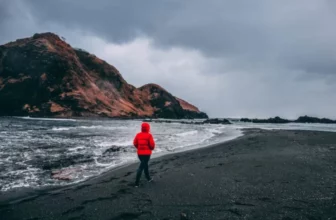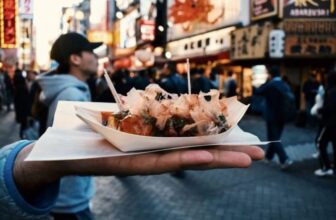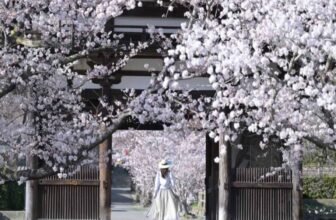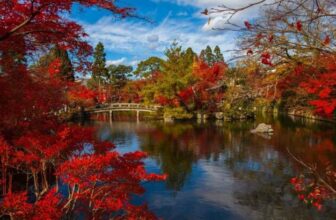Japan is a popular and exciting destination throughout the year and has unique experiences to offer in every season. During winter, the country turns into a spectacular snowy wonderland that will take your breath away.
Japan is a quirky destination with many weird and wonderful activities to enjoy. If you can deal with cold weather, you will find winter in Japan is a cozy and magical time to explore the beautiful scenery and unique activities without too many other tourists in your way.
Read on to discover some of the top winter activities and destinations that are not to be missed when visiting Japan during the winter holiday season.
How is the Winter Weather in Japan?
Winter months in Japan are between early December and mid-March. Depending on which area you visit, temperatures average between 25℉ and 45℉.
The southern part of Japan has a mild winter and is dry and sunny with temperatures rarely dropping below freezing. The further north you go, the colder it gets. The northernmost, mountainous parts of Japan experience a more severe winter with heavy snowfall and temperatures that drop below 10℉.
5 Fun Activities in Japan in Winter
1. Sapporo Snow Festival
The annual Sapporo Snow Festival is Japan’s largest winter festival that is hosted over seven days in February. Its main attractions are the spectacular, huge sculptures made of snow and ice.
The festival is a winter wonderland celebrating all things snow and ice and attracts over two million visitors yearly. It is a celebration of winter sports, art, local cuisines, and culture.
Sapporo is known for its specialty seafood, particularly crab-based cuisines, so be sure to try the famous crab nabe hot-pot to warm you up.
2. Ice Fishing in Lake Akan
Lake Akan in the eastern part of Hokkaido is a popular destination for ice fishing, and it is a winter experience unlike any other. Between January and March, the frozen lake is covered in colorful tents and eager tourists.
There are many local guides that will help you set up a tent, drill a hole in the ice, show you how to fish, and even fry up your catch on the spot. Vendors also sell warm sake (Japanese rice wine) that pairs nicely with fish and will keep you toasty on the frozen lake.
3. Tokyo Skytree Town Ice Skating Park
The Tokyo Skytree is an iconic attraction in Japan. It is the tallest tower in the world at 2,080 feet and is used for broadcasting and observation.
During the winter months, you can ice skate at the popular rink at the foot of the tower. It is even better at night when the tower is capped with snow and lit up with thousands of Christmas lights during the festive season.
4. Kusatsu Onsen
Onsen refers to natural hot spring waters, which is a popular attraction for locals and tourists alike. Japan is blessed with the world’s largest flow of hot spring water and offers many onsen destinations.
The most popular onsen is located in Kusatsu, a small town northwest of Tokyo. It is situated in the Gunma Prefecture and is close to 4,000 feet above sea level.
Kusatsu has a dedicated onsen resort where you can lounge in steamy, high-quality hot springs while enjoying traditional singing and dancing performances. The resort also offers skiing and hiking for adventurous visitors.
5. Tokyo Strawberry Park
Strawberry picking at Tokyo Strawberry Park is a fun activity for cold and rainy winter days. The adorable pink building houses many varieties of strawberries that are ready for picking from January to March.
If you have a sweet tooth, the park also offers a café where you can buy strawberry-based sweets and candies and cute souvenirs. It also has a cooking and baking facility where you can try your hand at decorating sweets and desserts and preserving the berries you picked.
This colorful, fruity oasis is a combination of technology, natural wonder and mouth-watering berries. It is reservation-only, so be sure to book a spot if you would like to take part in this fun experience.
5 Beautiful Places to Visit in Japan in Winter
1. The Blue Pond
The Blue Pond is an iconic image with its otherworldly, vivid blue color. It is a popular tourist destination and offers guided tours explaining the history and significance of the waters.
This man-made pond was created after the volcanic eruption of Mount Tokachi in 1988. It is not only a stunning sight, but also serves the purpose of protecting the nearby town of Biei from future volcanic mudflows.
2. Shirakawa-go Village
Shirakawa-go Village is a small, traditional village that is rich in culture and beautiful snowscapes during winter. The village is the perfect destination to visit if you want to immerse yourself in ancient Japanese culture.
The village was declared a UNESCO World Cultural Heritage Site for its cultural significance and unique gasshō-zukuri building style. The huts are built with wooden beams and steely sloped thatched roofs – some of them dating as far back as the 1800s.
This small Japanese mountain settlement is isolated from the rest of the world and experiences the heaviest snowfall in the country. It is a charming winter wonderland filled with rural beauty where you can enjoy nature in full.
3. Jigokudani Monkey Park
Known as ‘The Paradise of the Monkeys’, Jigokudani Monkey Park is a must-see in the winter.
The park is home to a large troop of wild Japanese macaques, commonly referred to as snow monkeys. These monkeys have adapted to extremely cold temperatures, and are a well-known tourist attraction in the Joshinetsu Kogen National Park.
During winter, these gentle, docile creatures descend from the forest to the valley of the Yokogu River. It is the only place in the world where you can see monkeys warming up and bathing in natural hot springs.
4. Kinkaku-Ji Temple
The Kinkaku-Ji Temple, also known as The Golden Pavilion, is an iconic Japanese site. Winter is a great time to visit, as the snow adds to the natural beauty, plus there are fewer tourists around.
This Zen Buddhist Temple is historic and tranquil, and features perfectly landscaped gardens with a reflective pond named Kyoko-Chi. It houses sacred Buddhist relics and ancient artifacts, too.
The three-story structure is most revered for the top two storys being covered in approximately 44 pounds of pure gold leaf. It dates back to the 1220s and was declared a UNESCO World Heritage Site for its historic and cultural significance.
5. Kanazawa City
Kanazawa City is located in the northwestern Hokuriku region, where heavy snowfall is experienced during winter. The area is a well-known Geisha and Samurai district, and you can watch performances and immerse yourself in ancient Japanese culture.
The town is known for its art museums and many traditional markets where you can buy handmade crafts and souvenirs. It also has many fine dining experiences where you can indulge in Japan’s best seafood.
One of the most popular features is the historic Kanazawa Castle dating back to 1583. During winter, this regal building is capped with snow and has spectacular scenery including frozen ponds and streams. There are also smaller snow festivals held in the castle’s amazing gardens during the snowy season.
FAQs
1. What Clothes Should I Pack when Visiting Japan in Winter?
To make the most of your winter visit to Japan, you need to be prepared when it comes to keeping warm. Thermal underwear and a wool coat are a must if you are traveling to the northern parts of the country. Waterproof boots, gloves, and a winter hat are also recommended.
If you are traveling through the southern parts of Japan, you can pack flexible layers such as long-sleeved tops, fleece jackets, and light scarves.
2. What Makes Winter in Japan Special?
Japan experiences heavy and consistent snowfall during winter, which makes for breathtaking scenery. There are also numerous winter sports resorts, which skiers and snowboarders consider the best in the world.
3. Is Japan Expensive During the Winter Months?
Winter is a great time for travelers on a budget, as it is the cheapest season to visit the country. An added benefit is that, between January and March, tourists are fewer and the top attractions are much less crowded. Take note that cash is king in Japan, and you might struggle to find an ATM or bank that accepts international cards.
4. What is the Coldest City in Japan?
Rikubetsu is widely known as the coldest city in Japan. It is situated on the edge of the Tokachi Plain in the Hokkaido region. The city has an altitude of 679 feet above sea level, which causes remarkably lower temperatures. The coldest time is between the end of January and mid-February, with temperatures dropping below -4℉.
5. Which Languages are Most Common in Japan?
The three most common languages in Japan are standard Japanese, Ryukyuan, and Okinawan. However, English is widely understood and spoken throughout the country.
















